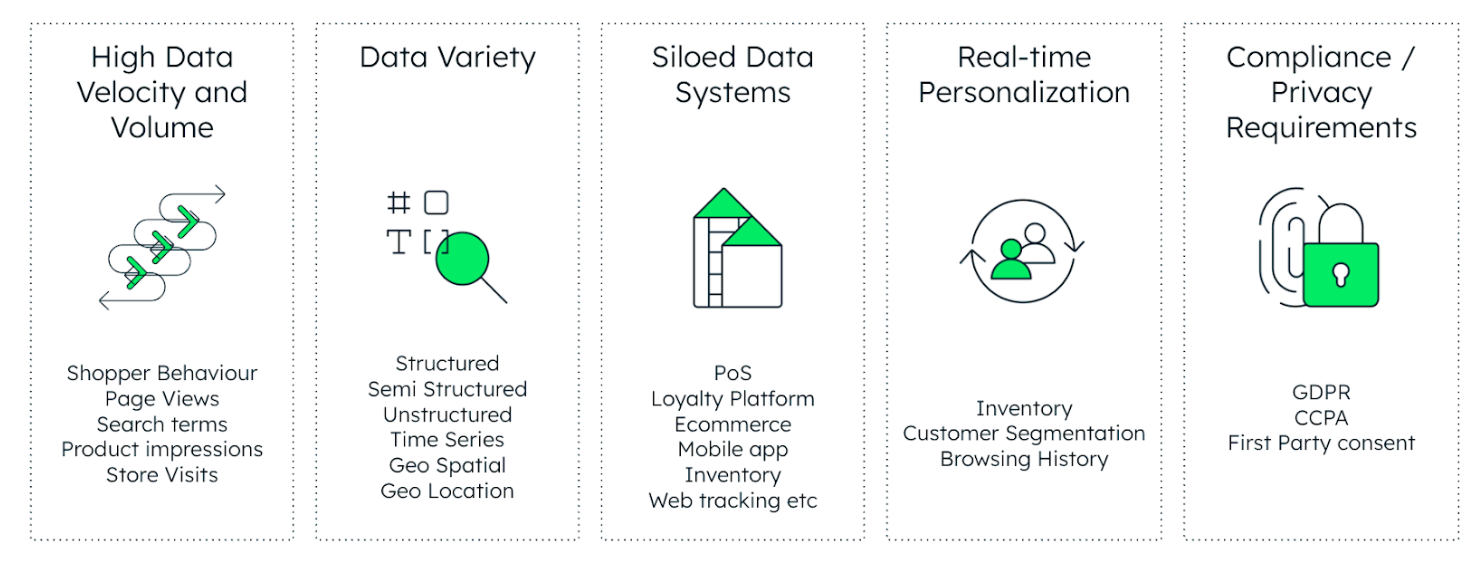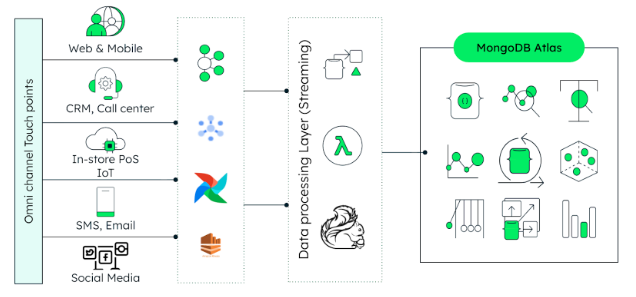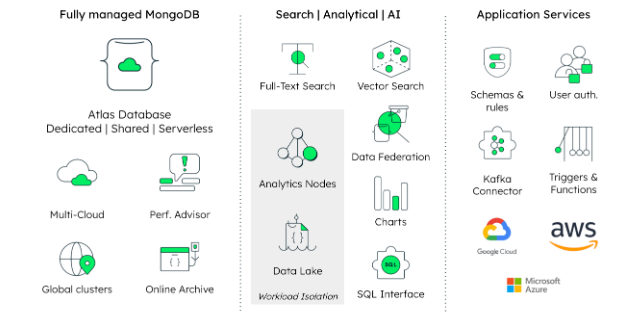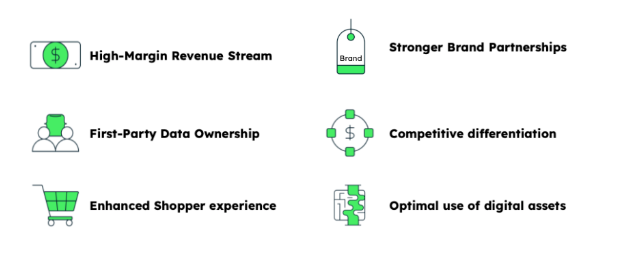Retailers today have access to a wealth of data that is an invaluable, unique asset that only they possess—such as first-party and customer interaction data. With the rapid evolution of digital commerce and the depreciation of third-party cookies, retail media networks (RMNs) have emerged as a critical channel for monetization and customer engagement. Through the strategic use of shopper data (which spans both digital and physical retail channels), retailers are empowered to provide brands with a unique opportunity to engage in direct advertising with in-market consumers, achieving an unprecedented level of precision and conversion. You can find more information on this in our blog post on Unified Commerce.
Major retailers are already generating significant amounts of high-margin revenue by operating retail media networks. However, building an RMN that’s truly performant, privacy-compliant, and personalized in real time is a data engineering feat that requires a modern data platform like MongoDB Atlas.
The opportunity ahead is enormous. Retail media is projected to reach $8.32 billion and to account for 16% of total digital ad revenue by 2027. And ad spending on retail media networks (RMNs) is predicted to exceed $100 billion by 2026, according to an estimate by McKinsey.
This blog post addresses a pivotal challenge faced by retail IT decision-makers: How do you enable a scalable, flexible, and intelligent data infrastructure that fuels this new ad business?

Retailers increasingly recognize the untapped potential of their customer data and the physical and digital shopping environments they curate. By strategically monetizing these assets, businesses can enhance customer experiences, unlock new revenue streams, and gain a competitive edge in the evolving retail landscape.
Retail media networks (RMNs) are an extension of a retailer’s digital ecosystem, enabling brands to advertise directly to shoppers using the retailer’s owned channels—such as websites, mobile apps, and in-store displays. Powered by rich first-party data, RMNs offer precise audience targeting and closed-loop attribution, giving brands greater visibility into campaign performance. RMNs unlock a high-margin revenue stream while deepening engagement with customers.
As part of a broader retail data strategy, RMNs elevate the role of customer and product data from operational assets to monetizable media enablers. This shift demands a modern, unified data infrastructure that can support real-time insights, personalization, and scale.
The data challenge in retail media networks
RMNs are complex digital ecosystems. To deliver real-time, personalized, measurable advertising, retailers must manage data at volume and must coordinate a variety of data (often spread across siloed systems) with real-time access to personalize advertisements based on context. This data spans structured formats like SKU-level inventory, semi-structured campaign configurations, and unstructured sources such as clickstream logs and customer reviews. Fragmented systems such as Point of Sale, loyalty programs, and ecommerce platforms—with distinct data sets required by RMNs— further complicate efforts to build a unified customer view. Delivering real-time, personalized ad experiences requires instant access to up-to-date inventory, segmentation, and behavioral context.
All of this must be managed under strict regulatory frameworks like GDPR and CCPA, demanding secure, consent-based handling of first-party data. To turn this complexity into a competitive advantage, retailers need a modern data platform that’s real-time, unified, and built for agility.

Data strategy for retail media networks with a modern data platform
A successful RMN data strategy starts with a few key principles: the unification of data across different systems of record; real-time data ingestion and activation; data model flexibility for evolving ad formats; scalability and performance for high-traffic campaigns; and most significantly, compliance and data governance. All of which capabilities MongoDB Atlas delivers.
Specifically, MongoDB Atlas empowers retail media networks with a flexible document model that stores diverse data sets like customer profiles, campaign metadata, clickstreams, and product catalogs in a JSON-native schema, as well as evolves with business needs. Real-time responsiveness is enabled through Change Streams, allowing systems to react instantly to inventory updates or shopper behavior. And with Atlas Data Federation, data teams can query across live clusters, S3, and data stores without ETL, simplifying both operational and analytical workloads.
MongoDB Atlas Search and MongoDB Atlas Vector Search further enhance targeting by combining full-text and semantic capabilities to surface the most relevant products or ads. All of this runs seamlessly across multiple clouds with built-in scaling (when adopted), ensuring global performance with minimal operational burden.

Key differentiators for IT Leaders to consider
- Rapid development: Developers work faster using a flexible, intuitive data model—critical when launching new ad formats or targeting criteria.
- Unified operational + transanalytical workloads: Run personalization, campaign reporting, and inventory lookups all on the same platform—no need for complex ETL or dual stacks.
- Powerful integrations: Atlas integrates out-of-the-box with data streaming platforms (Kafka), transformation engines (Spark), and cloud-native tools (AWS Lambda, GCP Pub/Sub).
- Secure & compliant by default: Features like encryption at rest, field-level security, access control, and audit logging help maintain governance and customer trust.
- Built for scale: Global sharding and autoscaling allow you to confidently run high-traffic ad campaigns without outages or performance hits.
MongoDB gives retailers the agility of a startup with the muscle of an enterprise platform.

Strategic benefits for retailers and brand advertisers
Retail media networks enable retailers with:
- New revenue stream: Monetize existing digital assets through ad placements and sponsored listings.
- Enhanced personalization: Deliver ads that match current intent—boosting loyalty and conversion.
- Data monetization: Leverage insights from shopper behavior, inventory, and promotions to optimize merchandising and pricing strategies.
Brands engaging retailers with these capabilities can benefit from:
- Better audience targeting: Leverage first-party data to reach real buyers, not just lookalikes.
- Full-funnel attribution: See performance from impression to click to conversion across devices.
- Campaign agility: Launch and optimize campaigns in real time based on actual shopping behavior.

With MongoDB Atlas, retail media networks can foster mutually beneficial relationships, enabling brands to achieve higher ROI through targeted campaigns and personalized customer experiences. Retailers, in turn, unlock new business growth by leveraging their rich first-party data to create compelling ad opportunities without compromising on data privacy or customer trust.
The flexibility and scalability of MongoDB Atlas empowers these networks to handle massive datasets, to support real-time analytics for campaign optimization, and rapidly to innovate new ad products, ultimately driving greater value for both advertisers and consumers.
Next Steps
Discover how MongoDB Atlas can help you deliver seamless customer experiences across all channels.
Ready to learn more about MongoDB? Head over to our Atlas Learning Hub to start building your MongoDB skills today.